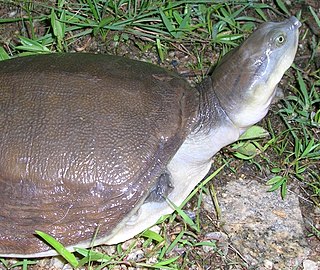Related Research Articles
Physeter is a genus of toothed whales. There is only one living species in this genus: the sperm whale. Some extremely poorly known fossil species have also been assigned to the same genus including Physeter antiquus from the Pliocene of France, and Physeter vetus from the Quaternary of the U.S. state of Georgia. Physeter vetus is very likely an invalid species, as the few teeth that were used to identify this species appear to be identical to those of another toothed whale, Orycterocetus quadratidens. The name is from Greek φυσητήρ (physētēr) 'blowpipe, blowhole .'

Pseudorca is a genus of cetaceans with three members which include Pseudorca yokoyamai, Pseudorca yuanliensis and Pseudorca crassidens, of which P. crassidens is the only extant member.

Carcharhinus is the type genus of the family Carcharhinidae, the requiem sharks. One of 12 genera in its family, it contains over half of the species therein. It contains 35 extant and eight extinct species to date, with likely more species yet to be described.

Lissemys is a genus of softshell turtles in the subfamily Cyclanorbinae of the family Trionychidae. The genus is indigenous to southern Asia.

Ailuravus is a genus of prehistoric rodents in the family Ischyromyidae.

Cycloderma is a genus of softshell turtles in the subfamily Cyclanorbinae of the family Trionychidae. The genus is endemic to Africa.

Fossilworks is a portal which provides query, download, and analysis tools to facilitate access to the Paleobiology Database, a large relational database assembled by hundreds of paleontologists from around the world.

Phlyctaeniidae is an extinct family of placoderm arthrodire fishes that lived during the Devonian period, mainly in Norway and North America.
The North American land mammal ages (NALMA) establishes a geologic timescale for North American fauna beginning during the Late Cretaceous and continuing through to the present. These periods are referred to as ages or intervals and were established using geographic place names where fossil materials were obtained.
The Deseadan age is a period of geologic time within the Oligocene epoch of the Paleogene to the Early Miocene epoch of the Neogene, used more specifically within the SALMA classification of South America. It follows the Tinguirirican and precedes the Colhuehuapian age.
The Laventan age is a period of geologic time within the Middle Miocene epoch of the Neogene, used more specifically within the SALMA classification in South America. It follows the Colloncuran and precedes the Mayoan age.
The Huayquerian age is a period of geologic time within the Late Miocene epoch of the Neogene, used more specifically within the SALMA classification. It follows the Chasicoan and precedes the Montehermosan age.

Colubroidea is a superfamily of snakes in the clade Colubroides that includes Colubridae, with some studies splitting Colubridae into multiple families that make up Colubroidea. Historically, Colubroidea also included other caenophidian snakes such as cobras and vipers, as these snakes form a clade. However these groups are now divided into several distinct, but related, families. Zaher et al. (2009) proposed to redefine Colubroidea for colubrids and related families, while designating Colubroides as the group containing vipers and cobras as well as colubroids. The ReptileDatabase considers Colubroidea to be composed of Colubridae and the members of its sister group, Elapoidea, and does not recognize the division of Colubridae into multiple families.

The Hiló Formation is a geological formation of the Altiplano Cundiboyacense, Eastern Ranges of the Colombian Andes. The predominantly shale formation dates to the Middle Cretaceous period; Late Albian to Early Cenomanian epochs and has a measured thickness at its type section of 470 metres (1,540 ft). The fossiliferous formation has provided a great abundance of ammonites and other marine species.

Boreostemma is an extinct genus of glyptodonts from northern South America. Fossils assigned to the genus were first described as belonging to Asterostemma from southern South America, but have been placed in the new genus Boreostemma by Carlini et al. in 2008. The type species is B. pliocena. Fossils of Boreostemma have been found in the Honda Group of Colombia, in Peru and Venezuela.

Miocochilius is an extinct genus of small notoungulate mammals (typotheres) native to South America. The genus lived during the Middle Miocene epoch. The genus contains two described species, the type species M. anomopodus described in 1953 by Ruben Arthur Stirton and M. federicoi, described and included in the genus by Darin A. Croft.

Thanatosdrakon is a genus of quetzalcoatline azhdarchid pterosaur from the Late Cretaceous Plottier Formation of the Neuquén Basin in western Argentina. The genus name is derived from the Greek words thanatos (=death) and drakon (=dragon), while the specific name is a Quechuan word meaning "flying serpent" and refers to the Incan deity Amaru. The type and only species is Thanatosdrakon amaru, known from two specimens consisting of several well-preserved axial and appendicular bones including material previously undescribed in giant azhdarchids. Thanatosdrakon is one of the oldest known members of the Quetzalcoatlinae. T. amaru lived from about 90 to 86 million years ago.
References
- ↑ "Fossilworks: Kueichowlepis". fossilworks.org. Retrieved 17 December 2021.
- ↑ Lucas, Spencer G. (2002-01-30). Chinese Fossil Vertebrates. Columbia University Press. ISBN 9780231504614.







